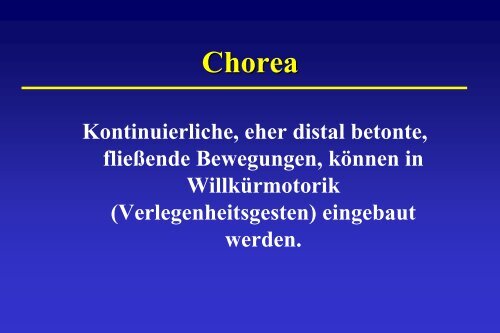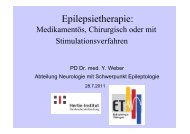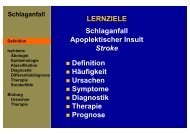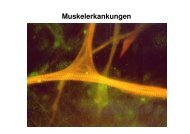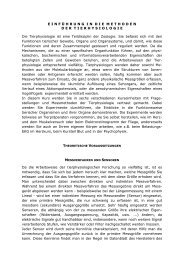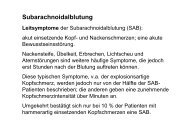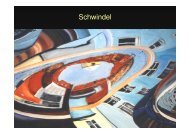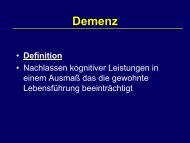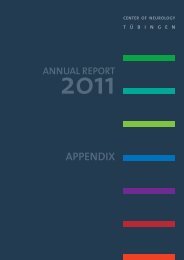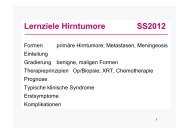Chorea
Chorea
Chorea
Erfolgreiche ePaper selbst erstellen
Machen Sie aus Ihren PDF Publikationen ein blätterbares Flipbook mit unserer einzigartigen Google optimierten e-Paper Software.
<strong>Chorea</strong><br />
Kontinuierliche, eher distal betonte,<br />
fließende Bewegungen, können in<br />
Willkürmotorik<br />
(Verlegenheitsgesten) eingebaut<br />
werden.
<strong>Chorea</strong>
<strong>Chorea</strong>
<strong>Chorea</strong>
<strong>Chorea</strong>: Differentialdiagnose<br />
• Erbliche Erkrankungen mit Beginn im Kindes- und<br />
Jugendalter<br />
– Wilson'sche Erkrankung<br />
– Hallervorden-Spatz Erkrankung<br />
– Benigne familiäre <strong>Chorea</strong><br />
• Erbliche Erkrankungen mit Beginn üblicherweise im<br />
Erwachsenenalter<br />
– <strong>Chorea</strong> Huntington<br />
– Neuroacanthocytose<br />
– Spinozerebelläre Degenerationen (v.a. SCA17)
<strong>Chorea</strong>: Differentialdiagnose<br />
• <strong>Chorea</strong> minor (Sydenham)<br />
• Schwangerschafts-<strong>Chorea</strong><br />
• Ischämie im Bereich der Basalganglien (einschl.<br />
Status lacunaris)<br />
• Medikamentös oder toxisch verursachte <strong>Chorea</strong><br />
– Dopaminagonisten (v.a. bei bestehender Parkinson<br />
Erkrankung)<br />
– Dopaminantagonisten (tardive Dyskinesien)<br />
– Antikonvulsiva
Differentialdiagnose <strong>Chorea</strong> mit<br />
Beginn im Kindes- u. Jugendalter<br />
• Benigne familiäre <strong>Chorea</strong><br />
– Autosomal dominant, Titf-1 Mutation<br />
– Hypothyreose, Entwicklungsrückstand<br />
• DD: Myoclonus-Dystonie-Syndrom<br />
– Autosomal-dominant, SGCE-Mutation
<strong>Chorea</strong> Huntington<br />
Symptomatik<br />
Bewegungsstörung<br />
<strong>Chorea</strong>, seltener Akinese, Dystonie, Rigor<br />
Persönlichkeitsveränderung Reizbarkeit,<br />
Depression<br />
Demenz
<strong>Chorea</strong> Huntington<br />
Verlauf<br />
Chronisch progredienter Verlauf<br />
Erkrankungsdauer: 10 bis 20 Jahre<br />
Tod durch Bettlägerigkeit,<br />
Schluckstörungen
<strong>Chorea</strong> Huntington<br />
Epidemiologie<br />
Prävalenz: 2 bis 7/100.000<br />
Erkrankungsbeginn: in 80% zwischen dem<br />
30. und 55. Lebensjahr
Huntington‘s disease
Huntington‘s disease<br />
gene mapping<br />
4p16.3<br />
Cosegregation of marker-locus and disease<br />
4 cM ~<br />
4 Mb<br />
diseased<br />
healthy<br />
A<br />
B<br />
C<br />
a<br />
b<br />
c<br />
A<br />
A<br />
A<br />
a<br />
Gusella et al, 1981<br />
Recombination<br />
b<br />
c<br />
B<br />
C<br />
b<br />
c<br />
b<br />
c
Huntington's disease<br />
IT15 = 'Huntingtin'<br />
1 2 3 4 5 6 7<br />
3694 bp<br />
5' 3'<br />
CCG TGT<br />
CAG CAG CAG CAG<br />
CAG CAG CAG CAG<br />
CTA ATT GAT<br />
Translation<br />
Pro Cys<br />
Glu Glu Glu Glu<br />
Glu Glu Glu Glu Leu Ile Asp<br />
348 kd
Huntington's disease<br />
Duayo et al., 1993
Huntington's disease<br />
Andrew et al., 1994
Huntington's disease<br />
treatment of movement disorder<br />
Generic name<br />
Initial<br />
dosage<br />
(mg/d)<br />
Therapeutic<br />
dosage<br />
(mg/d)<br />
Sulpiride 100 - 200 200 - 1200<br />
Tetrabenazine 25 50 - 200<br />
Haloperidol 2 5 - 10<br />
Perphenazine 4 8 - 12<br />
Pimozide 2 12 - 16
Huntington's disease<br />
treatment of psychiatric disturbances<br />
• Depression<br />
– tricyclic antidepressants<br />
– SSRI‘s<br />
• irritability and aggressiveness<br />
– SSRI‘s
CAG-repeat disorders<br />
Disease Symbol Position Gene product<br />
Huntington’s disease HD 4p16.3 Huntingtin<br />
Spinocerebellar ataxia type 1 SCA1 6p21.3 Ataxin 1<br />
Spinocerebellar ataxia type 2 SCA2 12q23 Ataxin 2<br />
Spinocerebellar ataxia type 3 SCA3 14q24 Ataxin 3<br />
Spinocerebellar ataxia type 6 SCA6 19p13 CACNL 14A<br />
Spinocerebellar ataxia type 7 SCA7 3p21 Ataxin 7<br />
Spinocerebellar ataxia type 12 SCA12 5q31 PPP2R2B<br />
Spinobulbar muscular atrophy SBMA Xq13-22 Androgen<br />
receptor


